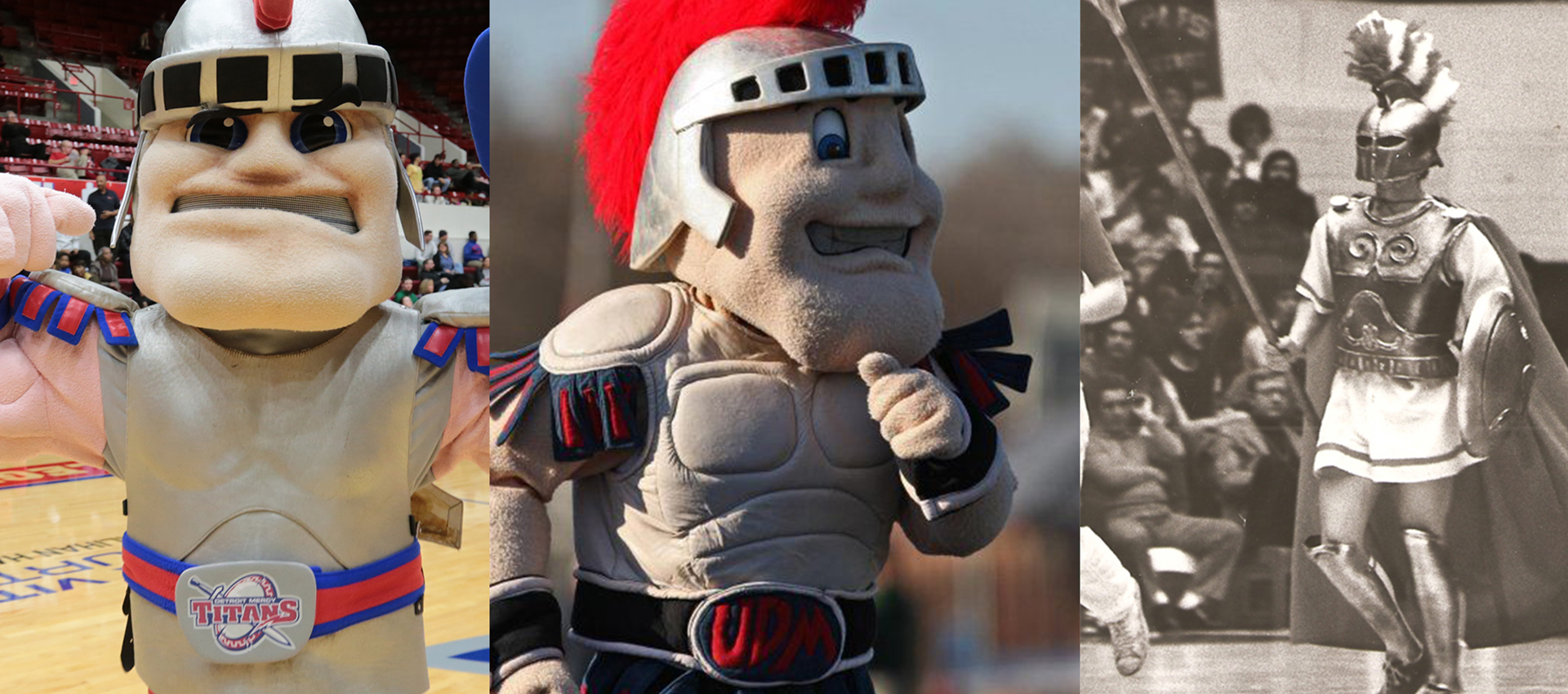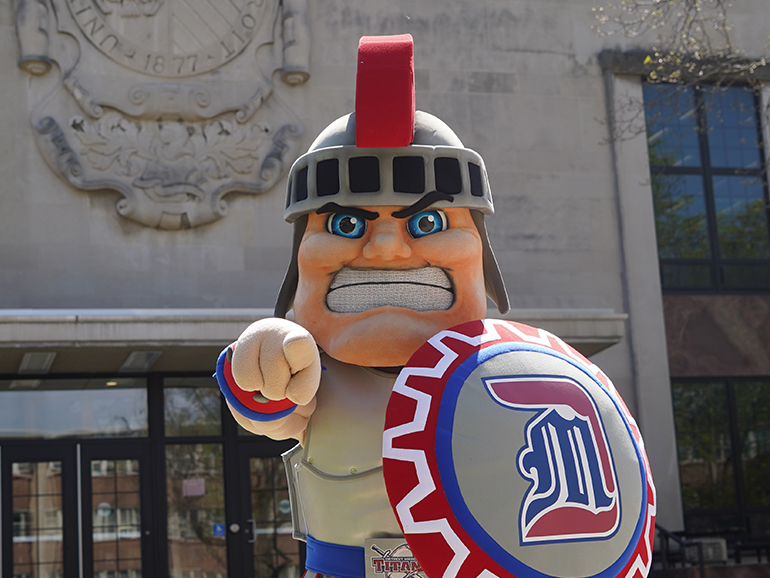Mascot origins: Titan collaboration helped ‘Tommy’ take off in 1977

A reader’s response to a feature on the new Tommy Titan in the Spring 2023 edition of Spiritus prompted a deeper dive into the origins of the beloved mascot. This story is featured in the Fall 2023 Spiritus magazine, arriving in mailboxes this week.
The Titan men’s basketball team was in the midst of a historic 1976-77 season — Dick Vitale’s last as head coach — yet something was lacking that many top institutions in that era possessed: A school mascot.
The University, which changed its nickname from “Tigers” to “Titans” in 1924 in part to avoid confusion with the city’s baseball team, had various St. Bernard puppies as mascots at U-D football games in the 1940s and 50s. But there hadn’t been a physical or caricature mascot since.
Behind a call from the University and assistance from both a U-D alumnus and student, that would change in time for a thrilling finish to a historic basketball campaign.
Ken Thelen ’72 and Tom Cieszkowski ’80 didn’t know each other beforehand, but both played vital roles in helping the first Titan mascot come to fruition in 1977.
 A couple of years earlier, in 1975, the Varsity News had begun to run advertisements for a student to fill the mascot role. On Feb. 1, 1977, the VN once again ran an ad from the Athletics Department.
A couple of years earlier, in 1975, the Varsity News had begun to run advertisements for a student to fill the mascot role. On Feb. 1, 1977, the VN once again ran an ad from the Athletics Department.
As a student, Cieszkowski already brought a lot of energy to Titan basketball games and figured if nobody answered the advertisement after an issue or two, he would throw his name in the hat.
“It was divine providence,” Cieszkowski said. “I was always jumping up and down in the seats. If I’m going to be excitable, I might as well be out there, being positive and bringing good energy.”
But before “Tommy” could spark the Titan faithful, he needed a costume fit for a Titan.
That’s where Thelen came in. A graduate from a few years prior who was enjoying the success of the Titan basketball team, Thelen wanted to help with the mascot project in any way he could.
The Titans had recently defeated rival Dayton on the road, were stringing wins together and had entered the top-20 rankings nationally.
“I was under-employed at the time and I took the day off and went down to the Memorial Building (now Calihan Hall),” Thelen said. “I knew Vitale, had spoken to him a few times. I told him I wanted to try and go to Marygrove College, I knew they had theatrical armor, so Vitale wrote me a letter, reading, ‘please give Ken any help you can, Dick Vitale.’”
While Marygrove couldn’t help Thelen with the armor he needed, they gave him an address to a place that could help, Tobins Lake Studios, near Ann Arbor. There, Thelen found everything he needed.
He bought five sheets of Vacuform, thick-gauged armor for $25, which was a considerable amount of money then. Thelen, however, knew someone in the Titan Club, who offered to cover the entire cost for the uniform.
After purchasing the sheets, the costume project turned into a family affair. Thelen’s wife, Nancy, made a white tunic with red trim on it and his father, Ken Thelen ’52, a skilled wood worker, crafted a spear for the Titan mascot.
 Thelen cut out the sheets for Greek armor, a breast plate, back plate and shin guards. He taped the edges and spray painted them black and then silver. He also created a helmet, which had a feather crest, red and white in alternating feathers.
Thelen cut out the sheets for Greek armor, a breast plate, back plate and shin guards. He taped the edges and spray painted them black and then silver. He also created a helmet, which had a feather crest, red and white in alternating feathers.
Cieszkowski made his debut as the mascot on Feb. 12, 1977, at Calihan Hall against Wayne State, a triumph and win No. 19 in the team’s win streak.
“I brought all of the stuff down there and we went into the locker room before the game and I showed him how it worked,” Thelen said. “He was fearsome, he looked like a Fifth-Century B.C. warrior and that’s kind of how we wanted to portray him as a Titan.”
Cieszkowski shined as the first mascot for a pivotal stretch of Titan basketball. He even signed autographs as “Tommy Titan” playing off his first name. The moniker was born.
Two games later, with Tommy Titan in attendance, the Titans defeated eventual 1977 NCAA champion Marquette on the road, 64-63, the 21st consecutive win that season, still a school record. Later that year, in a memorable moment for Cieszkowski, he chased a man across the court at Loyola University Chicago to retrieve his helmet the man had snatched off his head.
He later made the trip to the NCAA Tournament with the Titans, who were led by future NBA players Dennis Boyd, Terry Duerod, John Long and Terry Tyler. He was in attendance for the Titans’ first-ever NCAA Tournament win, a 93-76 triumph over Middle Tennessee State and then at Rupp Arena, where the Titans fell, 86-81, to Michigan, finishing the season 25-4.
“It was a thrill to be around the team and Dick Vitale,” Cieszkowski said. “He could make you run through a brick wall. It gave me a great opportunity.”
The first iteration of Tommy Titan lasted for a couple of seasons, with Cieszkowski passing off the role eventually to another student. He also transferred to Mercy College, where he finished his studies, becoming a true hybrid alumnus of UDM.
 After that, the Athletics Department went from a real, physical Titan to a caricature form of Tommy, where the identity of the person inside is hidden, such as the current Tommy that is visible at various events across the University’s campuses.
After that, the Athletics Department went from a real, physical Titan to a caricature form of Tommy, where the identity of the person inside is hidden, such as the current Tommy that is visible at various events across the University’s campuses.
But, even so, the loveable mascot was off and running permanently.
Thelen, who still brings his grandkids to games at Calihan Hall, takes pride in his role in helping the mascot come to life in the school he attended.
“It had been working in my mind for a couple of years,” he said of the idea for the mascot. “I’d go on the road and they all had mascots. When we beat Dayton on the road that season, I was fired up, the alumni were fired up. It was the perfect storm, so I did it.”
Cieszkowski, who embraced the spirit of U-D so much he painted a University logo on his car, was in the perfect position to portray the first “Tommy.”
“I felt the best that I was enthusiastic at every game,” he said. “I let the spirit flow through me. There was something guiding me and I enjoyed creating a little atmosphere, encouraging people when we were down or behind, or leading a cheer. I’d get out in the middle of the court when we were hoping to make a comeback. It was a fortuitous, fulfilling experience.”
— By Adam Bouton. Follow Detroit Mercy on Facebook, LinkedIn, X and Instagram. Have a story idea? Let us know by submitting your idea.
